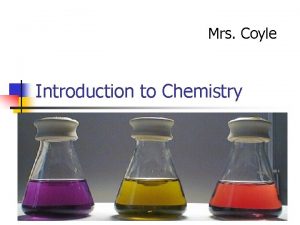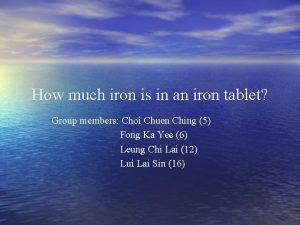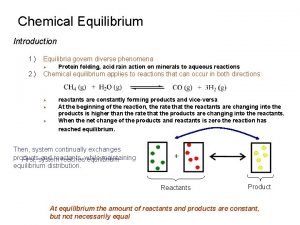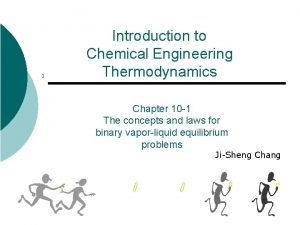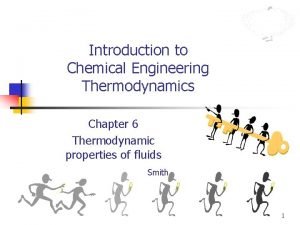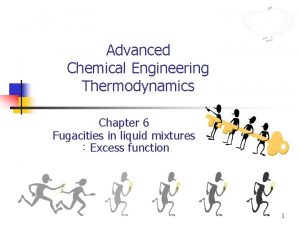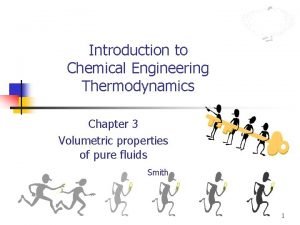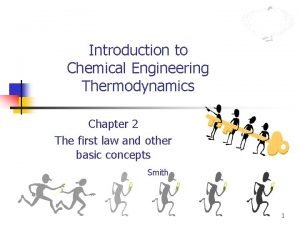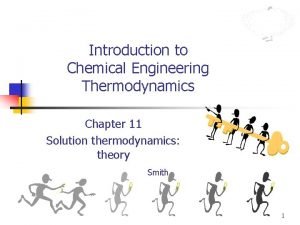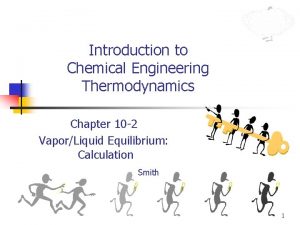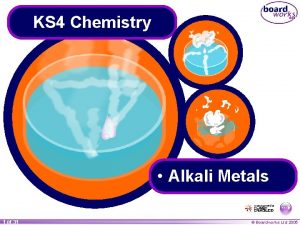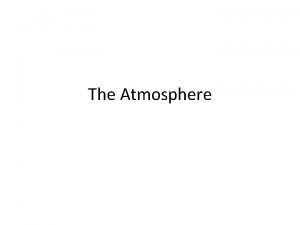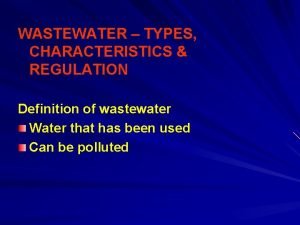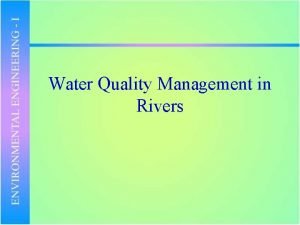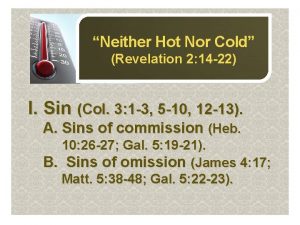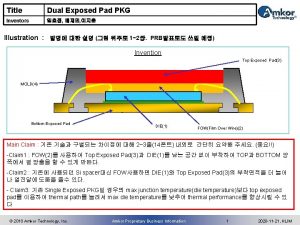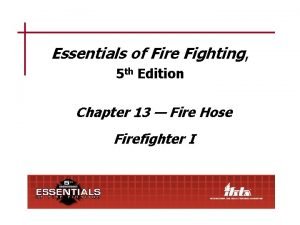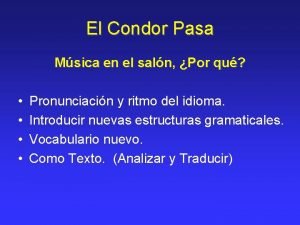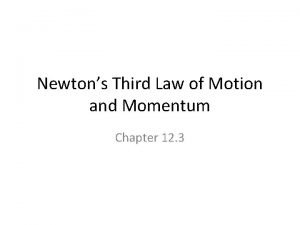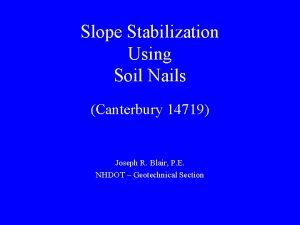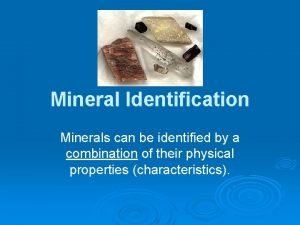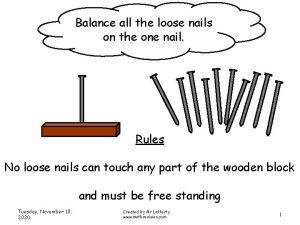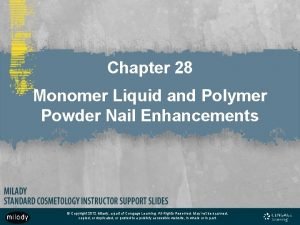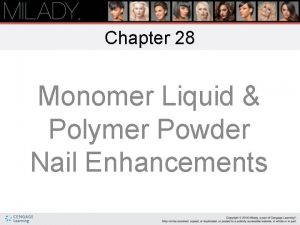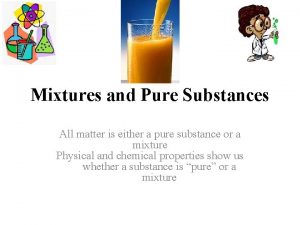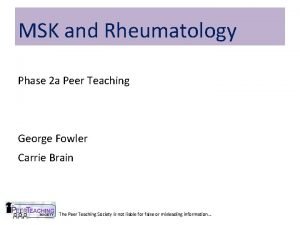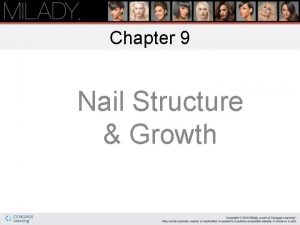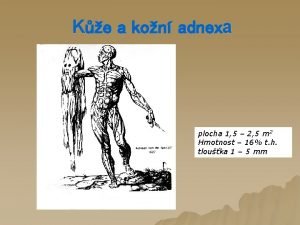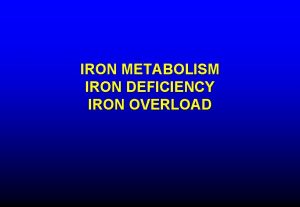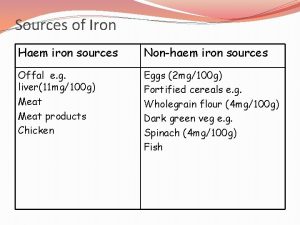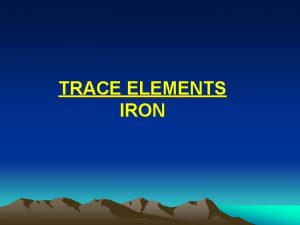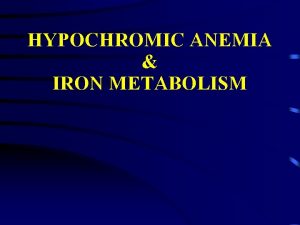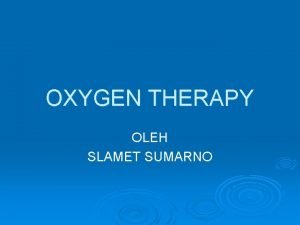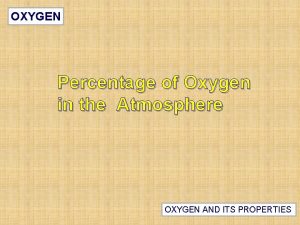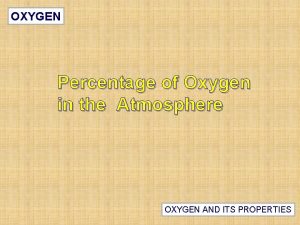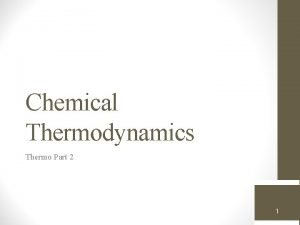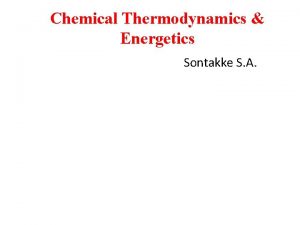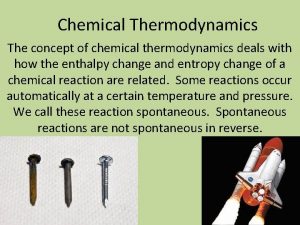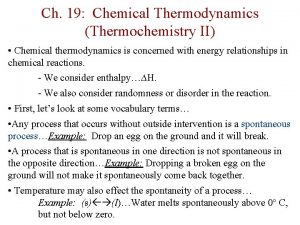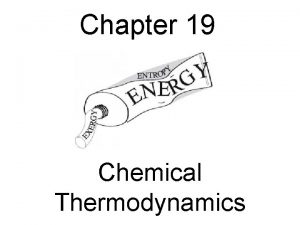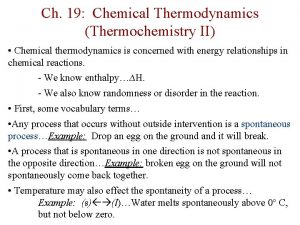CHEMICAL THERMODYNAMICS Hot iron nail exposed to oxygen








































































- Slides: 72

CHEMICAL THERMODYNAMICS Hot iron nail exposed to oxygen releases lots of heat energy.

The Nature of Energy I. Types of energy: A. Kinetic Energy – energy of motion B. Potential Energy – energy due to condition, position, or composition C. Internal energy D. Heat energy, electricity II. Units for energy: A. calorie – (cal) quantity of heat required to change the temperature of one gram of water by one degree Celsius B. Joule (J) – SI unit for heat 1 cal = 4. 184 J

Chemical Energy Is Mainly Potential Energy • The most important form of potential energy in molecules is electrostatic potential energy, Eel: • Reminder: the unit of energy commonly used is the Joule:

Attraction Between Ions • Electrostatic attraction is seen between oppositely charged ions. • Energy is released when chemical bonds are formed; energy is consumed when chemical bonds are broken.

Internal Energy (1 of 2) • The internal energy of a system is the sum of all kinetic and potential energies of all components of the system; we use E to represent it. • We generally don’t know E, only how it changes

Internal Energy (2 of 2) By definition, the change in internal energy, is the final energy of the system minus the initial energy of the system:

UNITS for HEAT ENERGY Heat energy is usually measured in either Joules, given by the unit (J), and kilojoules (k. J) or in calories, written shorthand as (cal), and kilocalories (kcal). 1 cal = 4. 184 J NOTE: This conversion correlates to the specific heat of water which is 1 cal/g o. C or 4. 184 J/g o. C.

Units of Energy • joule (J) is the amount of energy needed to move a 1 kg mass a distance of 1 meter – 1 J = 1 N∙m = 1 kg∙m 2/s 2 • calorie (cal) is the amount of energy needed to raise one gram of water by 1°C – kcal = energy needed to raise 1000 g of water 1°C – food Calories = kcals Energy Conversion Factors 1 calorie (cal) 1 Calorie (Cal) 1 kilowatt-hour (k. Wh) 8 = = = 4. 184 joules (J) (exact) 1000 calories (cal) 3. 60 x 106 joules (J)

THERMODYMANICS Thermodynamics is the study of the motion of heat energy as it is transferred from the system to the surrounding or from the surrounding to the system. System – the portion of the universe selected for thermodynamic study Surroundings – the portion of the universe with which a system interacts The transfer of heat could be due to a physical change or a chemical change. There are three laws of chemical thermodynamics

CHEMICAL THERMODYMANICS The first law of thermodynamics: Energy and matter can be neither created nor destroyed; only transformed from one form to another. The energy and matter of the universe is constant. The second law of thermodynamics: In any spontaneous process there is always an increase in the entropy of the universe. The entropy is increasing. The third law of thermodynamics: The entropy of a perfect crystal at 0 K is zero. There is no molecular motion at absolute 0 K.

HEAT The energy that flows into or out of a system because of a difference in temperature between thermodynamic system and its surrounding. Symbolized by "q". ðWhen heat is evolved by a system, energy is lost and "q” is negative (-). ðWhen heat is absorbed by the system, the energy is added and "q" is positive (+).

HEAT FLOW Heat can flow in one of two directions: Exothermic To give off heat; energy is lost from the system: (-q) Endothermic To absorb heat; energy is added to the system: (+q)

Changes in Internal Energy (1 of 2) the system absorbed energy from the surroundings.

Changes in Internal Energy (2 of 2) the system released energy to the surroundings.

The First Law of Thermodynamics- A closer look “The internal energy ( E) of an isolated system is constant. ” Internal Energy: the sum of all the kinetic/potential energy of a system. E = Efinal – Einitial & E = q + w NOTE: q = heat added to or liberated from the system Heat (q) = the energy transferred from a hotter object to a colder one w = work done on or by the system. Work (w) = the energy used to cause one object to move against a force

Changes in Internal Energy • When energy is exchanged between the system and the surroundings, it is exchanged as either heat (q) or work (w). • That is,

Sign Convention for q q > 0: Heat is transferred from the surroundings to the system Sign Convention for w w > 0: Work is done by the surroundings on the system q < 0: Heat is transferred from the system to the surroundings w < 0: Work is done by the system on the surroundings When heat is transferred from the surroundings to the system, q has a positive value. Likewise, when work is done on the system by the surroundings, w has a positive value. Both heat added to the system and the work done on the system INCREASE its internal energy. A POSITIVE value of E indicates that the system has gained energy from its surroundings; a NEGATIVE value of E indicates that the system has lost energy to its surroundings.

Pressure -Volume Work • PV work is work that is the result of a volume change against an external pressure • when gases expand, V is +, but the system is doing work on the surroundings so w is ─ • as long as the external pressure is kept constant ─Work = External Pressure x Change in Volume w = ─P V – to convert the units to joules use 101. 3 J = 1 atm∙L

Example– If a balloon is inflated from 0. 100 L to 1. 85 L against an external pressure of 1. 00 atm, how much work is done? Given: Find: Concept Plan: V 1=0. 100 L, V 2=1. 85 L, P=1. 00 atm w, J P, V w Relationships: 101. 3 J = 1 atm L Solution: Check: the unit and sign are correct

Lecture Questions on the first law of thermodynamics. Q #1: An automobile engine does 520 k. J of work and loses 220 k. J of energy as heat. What is the change in internal energy of the engine? Q #2: A system was heated by using 300 J of heat, yet it was found that its internal energy decreased by 150 J. Was work done on the system or did the system do work?

Enthalpy of Reaction (1 of 2) is the enthalpy of the products minus the enthalpy of the reactants: The change in enthalpy,

Enthalpy of Reaction (2 of 2) This quantity, heat of reaction. is called the enthalpy of reaction, or the

If the heat transfer involves a chemical reaction then q is called: HEAT OF REACTION The heat energy ( H; enthalpy) required to return a system to the given temperature at the completion of the reaction. q = H at constant pressure The heat of reaction can be specific to a reaction like: HEAT OF COMBUSTION The quantity of heat energy given off when a specified amount of substance burns in oxygen. UNITS: k. J/mol (kilojoules per mole) or kcal/mol (kilocalories per mole)


State Functions (1 of 3) • Usually we have no way of knowing the internal energy of a system; finding that value is simply too complex a problem. • However, we do know that the internal energy of a system is independent of the path by which the system achieved that state. – In the system below, the water could have reached room temperature from either direction.

State Functions (2 of 3) • Therefore, internal energy is a state function. • It depends only on the present state of the system, not on the path by which the system arrived at that state. • And so,

State Functions (3 of 3) • However, q and w are not state functions. • Whether the battery is shorted out or is discharged by running the fan, its is the same, but q and w are different in the two cases.

Enthalpy is the internal energy plus the product of pressure and volume: H = E + PV When the system changes at constant pressure, the change in enthalpy becomes, H = (E + PV) or H = E + P V BUT! which we can substitute these into the enthalpy expression: • So, at constant pressure, the change in enthalpy is the heat gained or lost.

Enthalpy The change in enthalpy, H, equals the heat gained or lost by the system when the process occurs under constant pressure (qp). i. H = Hfinal – Hinitial = qp ii. A positive value of H indicates that the system has gained heat from the surroundings. iii. A negative value of H indicates that the system has released heat to the surroundings. iv. Enthalpy is a state function.

Enthalpy Thermodynamic Equations Rules: i. H value is dependent on the phase of the substance. 2 H 2(g) + O 2(g) → 2 H 2 O(g) ; H = -483. 7 k. J 2 H 2(g) + O 2(g) → 2 H 2 O(l) ; H = -571. 7 k. J ii. When a thermodynamic equation is multiplied by a factor, the H is also multiplied by the same factor. 4 H 2(g) + 2 O 2(g) → 4 H 2 O(g) ; H = -967. 4 k. J iii. H value is dependent on the direction of the equation. 2 H 2 O(g) → 2 H 2(g) + O 2(g); H = +483. 7 k. J

Lecture Questions on enthalpy 1. In the presence of a Pt catalyst, NH 3 will burn in air to give NO. Consider the following gas phase reactions: 4 NH 3 + 5 O 2 → 4 NO + 6 H 2 O; H = -906 k. J What is H for: a) 8 NH 3 + 10 O 2 → 8 NO + 12 H 2 O b) NO + 3/2 H 2 O → NH 3 + 5/4 O 2? 2. Consider the reaction A X. The enthalpy change for the reaction represented above is HT. This reaction can be broken down into a series of steps as shown in the following diagram: Determine the relationship that must exist among the various enthalpy changes in the pathways shown above.

Lecture Questions on Stoichiometry & Enthalpy of Reaction 3 a. Hydrogen sulfide burns in air to produce sulfur dioxide and water vapor. If the heat of reaction is -1037 k. J for this reaction, calculate the enthalpy change to burn 36. 9 g of hydrogen sulfide in units of kcal? 3 b. Sulfur dioxide reacts with water to form hydrogen sulfide gas. What is the enthalpy change for this reaction? 3 c. Label both of the above reactions as either endothermic or exothermic.

Summary of Enthalpies of Reaction ( Hrxn) the enthalpy change that accompanies a reaction. A. For an ENDOTHERMIC reaction, the reactants have lower enthalpies than do the products ( H is positive). B. For an EXOTHERMIC reaction, the reactants have higher enthalpies than do the products ( H is negative). C. Two important rules to apply: 1. The magnitude of H is directly proportional to the amount of reactants or products. For example, the combustion of one mole of methane evolves 890 k. J of heat: CH 4(g) + 2 O 2(g) CO 2(g) + 2 H 2 O(l) H = -890 k. J The combustion of 2 moles of methane produces 2(-890 k. J) or -1780 k. J of heat. 2. H for a reaction is equal in magnitude but opposite in sign to H for the reverse reaction. For example, CO 2(g) + 2 H 2 O(l) CH 4(g) + 2 O 2(g) H = 890 k. J

Workshop EN#1 on Stoichiometry & Enthalpy of Reaction 1. How much heat is released when 4. 50 g of methane gas is burned in a constant pressure system? Is this reaction endothermic or exothermic? CH 4(g) + 2 O 2(g) CO 2(g) + 2 H 2 O(l) H = -890 k. J 2. Hydrogen peroxide can decompose to water and oxygen by the reaction: 2 H 2 O 2(l) 2 H 2 O(l) + O 2(g) H = -196 k. J Calculate the value of q when 5. 00 g of H 2 O 2(l) decomposes at constant pressure. 3. Use the standard heats of reaction given below to determine H for the following reaction (in kcal): 3 V 2 O 3(s) V 2 O 5(s) + 4 VO(s) + O 2(g) 2 V 2 O 3(s) H = -180 kcal 2 V 2 O 3(s) + O 2(g) 4 VO 2(s) H = -108 kcal 4 VO 2(s) + O 2(g) 2 V 2 O 5(s) H = -58 kcal

Hess’s Law • Hess’s law: If a reaction is carried out in a series of steps, ΔH for the overall reaction equals the sum of the enthalpy changes for the individual steps. • Because H is a state function, for a particular set of reactants and products, ΔH is the same whether the reaction takes place in one step or in a series of steps.

Hess’s Law If a reaction is carried out in a series of steps, H for the reaction will be equal to the sum of the enthalpy changes for the individual steps. For example, consider the reaction of tin and chlorine: Sn(s) + Cl 2(g) Sn. Cl 2(s) + Cl 2(g) Sn. Cl 4(l) Add up both reactions to obtain: Sn(s) + 2 Cl 2(g) Sn. Cl 4(l) H = -350 k. J H = -195 k. J H = -545 k. J

The Combustion of CH 4

Sample 1 - Calculate the Enthalpy Change in the Reaction from theory 2 C 2 H 2(g) + 5 O 2(g) 4 CO 2(g) + 2 H 2 O(l) 1. Write formation reactions for each compound from its elements and determine the Hf° for each: 2 C(s, gr) + H 2(g) C 2 H 2(g) Hf° = +227. 4 k. J/mol C(s, gr) + O 2(g) CO 2(g) Hf° = -393. 5 k. J/mol H 2(g) + ½ O 2(g) H 2 O(l) Hf° = -285. 8 k. J/mol

Sample 1 - Calculate the Enthalpy Change in the Reaction from theory 2 C 2 H 2(g) + 5 O 2(g) 4 CO 2(g) + 2 H 2 O(l) 2. Arrange equations so they add up to desired reaction 2 C 2 H 2(g) 4 C(s) + 2 H 2(g) H° = 2(-227. 4) k. J 4 C(s) + 4 O 2(g) 4 CO 2(g) H° = 4(-393. 5) k. J 2 H 2(g) + O 2(g) 2 H 2 O(l) H° = 2(-285. 8) k. J 2 C 2 H 2(g) + 5 O 2(g) 4 CO 2(g) + 2 H 2 O(l) H = -2600. 4 k. J 39

Lecture Questions on Hess’s Law 1. 2 C(graphite) + O 2(g) → 2 CO (g) ; H = ? Consider: CO 2(g) → CO(g) + ½ O 2 (g) ; H = +283. 0 k. J C(s) + O 2(g) → CO 2(g) ; H = -393. 5 k. J 2. Acetic acid is contained in vinegar. Suppose the following occurred: 2 C(graphite) + 2 H 2 (g) + O 2(g) → CH 3 COOH(l); H=? HC 2 H 3 O 2(l) + 2 O 2(g) → 2 CO 2(g) + 2 H 2 O(l); H= -871 k. J H 2(g) + ½ O 2(g) → H 2 O(l) ; H = -286 k. J C(graphite) + O 2(g) → CO 2 (g) ; H = -394 k. J

Workshop EN#2 on Hess’s Law 1. Consider the synthesis of propane from solid carbon and hydrogen gas. Determine the enthalpy change for 1 mol of gaseous propane given the following thermochemical data: C 3 H 8(g) + 5 O 2(g) 3 CO 2(g) + 4 H 2 O(l) H = -2220 k. J C(s) + O 2(g) CO 2(g) H = -394 k. J H 2(g) + ½O 2(g) H 2 O(l) H = -286 k. J 2. Diborane (B 2 H 6) is a highly reactive boron hydride which was once considered as a possible rocket fuel for the U. S. space program. Calculate the H for the synthesis of diborane from its elements according to the equation: 2 B(s) + 3 H 2(g) B 2 H 6(g) using the following data: (a) 2 B(s) + 3/2 O 2(g) B 2 O 3(s) H = -1273 k. J (b) B 2 H 6(g) + 3 O 2(g) B 2 O 3(s) + 3 H 2 O(g) H = -2035 k. J (c) H 2(g) + ½ O 2(g) H 2 O(l) H = -286 k. J (d) H 2 O(l) H 2 O(g) H = 44 k. J

Standard Enthalpies of Formation ( Hf ) the change in enthalpy for the reaction that forms 1 mol of the compound from its elements, with all substances in their standard states (i. e. 298 K). i. A table of Standard Heats of Formation for some compounds is found in your textbook ii. H for a reaction is equal to the sum of the heats of formation of the product compounds minus the sum of the heats of formation of the reactant compounds. Using the symbol to represent the “sum of”: Hrxn = n Hf (products) - m Hf (reactants) where n and m are the stoichiometric coefficients of the reaction.

Sample 2 - Calculate the Enthalpy Change in the Reaction using the appendix tables 2 C 2 H 2(g) + 5 O 2(g) 4 CO 2(g) + 2 H 2 O(l) H°reaction = n Hf°(products) - n Hf°(reactants) Hrxn = [(4 • HCO 2 + 2 • HH 2 O) – (2 • HC 2 H 2 + 5 • HO 2)] Hrxn = [(4 • (-393. 5) + 2 • (-285. 8)) – (2 • (+227. 4) + 5 • (0))] Hrxn = -2600. 4 k. J

Lecture Questions: 1. Calculate the standard enthalpy of reaction for the following reaction: 4 NH 3(g) + 5 O 2(g) 4 NO(g) + 6 H 2 O(l) Hf (NH 3) = -132. 5 k. J/mol; Hf (NO) = 90. 37 k. J/mol; Hf (H 2 O) = -285. 83 k. J/mol 2. Use the enthalpy of combustion of propane gas to calculate the enthalpy of formation of propane gas. C 3 H 8(g) + 5 O 2(g) 3 CO 2(g) + 4 H 2 O(l) Hc = -2220 k. J Hf (CO 2) = -393. 5 k. J/mol; Hf (H 2 O) = -285. 83 k. J/mol

Breakout/CHAT on Standard Enthalpy: 1. Calculate the standard enthalpy of reaction for the following reactions: a) 2 NO(g) + O 2(g) → 2 NO 2(g) b) 2 NH 3(g) + 7/2 O 2(g) → 2 NO 2(g) + 3 H 2 O(g) c) Fe 2 O 3(s) + 3 CO(g) → 2 Fe(s) + 3 CO 2(g) d) Ba. CO 3(s) → Ba. O(s) + CO 2(g) 2. (a) Calculate the heat required to combust 10. 0 g of nitrogen monoxide. (b) Calculate the heat required to combust 25. 0 g of ammonia. (c) Calculate the heat required to produce 25. 0 g of iron from iron(III) oxide. (d) Calculate the heat required to decompose 10. 0 g of barium carbonate.

Calorimetry • Since we cannot know the exact enthalpy of the reactants and products, we measure through calorimetry, the measurement of heat flow. • The instrument used to measure heat flow is called a calorimeter.

Heat Capacity and Specific Heat The amount of energy required to raise the temperature of a substance by 1 K (1 degree Celsius) is its heat capacity. If the amount of the substance heated is one gram, it is the specific heat. If the amount is one mole, it is the molar heat capacity. Table 5. 2 Specific Heats of Some Substances at 298 K Elements Blank Substance Compounds Blank Specific Heat (J/g-K) Substance Specific Heat (J/g-K) N 2(g) 1. 04 H 2 O(l) 4. 18 Al(g) 0. 90 CH 4(g) 2. 20 Fe(s) 0. 45 CO 2(g) 0. 84 Hg(l) 0. 14 Ca. CO 3(s) 0. 82

Calorimetry – measurement of heat flow HEAT CAPACITY: The quantity of heat needed to raise the temperature of a substance one degree Celsius (or one Kelvin). If the system is a mole of a substance, we use the term molar heat capacity q = C p T SPECIFIC HEAT: The quantity of heat required to raise the temperature of one gram of a substance by one degree Celsius (or one Kelvin). q = s x m x T ***NOTE: BOTH s and C will be provided on a case-by-case basis. You MUST memorize the specific heat of water, 1 cal/g C = 4. 184 J/g C. Both Cp & s are chemical specific constants found in the textbook or CRC Handbook.

LAW OF CONSERVATION OF ENERGY (LCE) • The law of conservation of energy (the first law of thermodynamics), when related to heat transfer between two objects, can be stated as: The heat lost by the hot object = the heat gained by the cold object -qhot = qcold -mh x sh x Th = mc x sc x Tc where T = Tfinal – Tinitial

Lecture Questions on SPECIFIC HEAT & LCE 1. Exactly 500. 00 k. J of heat is absorbed by a sample of gaseous He. The temperature increases by 15. 0 K. a) Calculate the heat capacity of the sample. b) the sample weighs 6. 42 kg. Compute the specific heat and molar heat capacity of He. 2. Assuming no heat is lost, what mass of cold water at 0. 00 o. C is needed to cool 100. 0 g of water at 97. 6 o. C to 12. 0 o. C? -mh x sh x Th = mc x sc x Tc 3. Calculate the specific heat of an unknown metal if a 92. 00 g piece at 100. 0 o. C is dropped into 175. 0 m. L of water at 17. 8 o. C. The final temperature of the mixture was 39. 4 o. C.

Workshop EN#4 on Specific heat & LCE 1. Determine the energy (in k. J) required to raise the temperature of 100. 0 g of water from 20. 0 o. C to 85. 0 o. C? 2. Determine the specific heat of an unknown metal that required 2. 56 kcal of heat to raise the temperature of 150. 00 g from 15. 0 o. C to 200. 0 o. C? 3. Assuming no heat is lost to the surronding, what will be the final temperature when 50. 0 g of water at 10. 0 o. C is mixed with 10. 0 g of water at 50. 0 o. C?

Exchanging Energy Between System and Surroundings • exchange of heat energy q = mass x specific heat x Temperature • exchange of work w = −Pressure x Volume

Bomb Calorimeter • used to measure E because it is a constant volume system

Bomb Calorimetry (1 of 2) • Reactions can be carried out in a sealed “bomb” such as this one. • The heat absorbed (or released) by the water is a very good approximation of the enthalpy change for the reaction. •

Bomb Calorimetry (2 of 2) • Because the volume in the bomb calorimeter is constant, what is measured is really the change in internal energy, • For most reactions, the difference is very small.

Example – When 1. 010 g of sugar is burned in a bomb calorimeter, the temperature rises from 24. 92°C to 28. 33°C. If Ccal = 4. 90 k. J/°C, find E for burning 1 mole Given: Find: 1. 010 g C 12 H 22 O 11, T 1 = 24. 92°C, T 2 = 28. 33°C, Ccal = 4. 90 k. J/°C Erxn, k. J/mol Concept C , T cal Plan: Relationships: Solution: Check: qcal = Ccal x T = -qrxn MM C 12 H 22 O 11 = 342. 3 g/mol the units and sign are correct 56 qrxn

Constant Pressure Calorimetry • By carrying out a reaction in aqueous solution in a simple calorimeter, the heat change for the system can be found by measuring the heat change for the water in the calorimeter. • The specific heat for water is 4. 184 J/g∙K. We use this value for dilute solutions. • We can calculate ΔH for the reaction with this equation:

Calorimetry and Chemical Reactions A heat of reaction, qrxn, is the quantity of heat exchanged between a system and its surroundings when a chemical reaction occurs within the system at constant temperature. If this reaction occurs in an isolated system, the reaction produces a change in thermal energy of the system. That is, the overall temperature either increases (exothermic; becomes warmer) or decreases (endothermic; becomes cooler). Heats of reaction are experimentally determined in a calorimeter, a device for measuring quantities of heat. Two common calorimeters are: (1) bomb calorimeter (used for combustion reactions) and (2) “coffee-cup” calorimeter (a simple calorimeter for general chemistry laboratory purposes built from styrofoam cups). As previously mentioned, the heat of reaction is the quantity of heat the system would have to lose to its surroundings to be restored to its initial temperature. This quantity of heat is the negative of thermal energy gained by the calorimeter and its contents (qcalorimeter). Therefore: qrxn = -qcalorimeter.

Example : Measuring ΔH Using a Coffee-Cup Calorimeter When a student mixes 50 m. L of 1. 0 M HCl and 50 m. L of 1. 0 M Na. OH in a coffee-cup calorimeter, the temperature of the resultant solution increases from 21. 0 to 27. 5 °C. Calculate the enthalpy change for the reaction in k. J/mol HCl, assuming that the calorimeter loses only a negligible quantity of heat, that the total volume of the solution is 100 m. L, that its density is 1. 0 g/m. L, and that its specific heat is 4. 18 J/g-K. Solution Analyze Mixing solutions of HCl and Na. OH results in an acid-base reaction: HCl(aq) + Na. OH(aq) H 2 O(l) + Na. Cl(aq) We need to calculate the heat produced per mole of HCl, given the temperature increase of the solution, the number of moles of HCl and Na. OH involved, and the density and specific heat of the solution. Plan The total heat produced can be calculated using Equation 5. 22. The number of moles of HCl consumed in the reaction must be calculated from the volume and molarity of this substance, and this amount is then used to determine the heat produced per mol HCl. Solve Because the total volume of the solution is 100 m. L, its mass is: (100 m. L)(1. 0 g/m. L) = 100 g The temperature change is: Using Equation 5. 22, we have: ΔT = 27. 5 °C – 21. 0 °C = 6. 5 K

Example : Measuring ΔH Using a Coffee-Cup Calorimeter Continued Because the process occurs at constant pressure, ΔH = q. P = – 2. 7 k. J To express the enthalpy change on a molar basis, we use the fact that the number of moles of HCl is given by the product of the volume (50 m. L = 0. 050 L) and concentration (1. 0 M = 1. 0 mol/L) of the HCl solution: Thus, the enthalpy change per mole of HCl is: ΔH = – 2. 7 k. J/0. 050 mol = – 54 k. J/mol Check ΔH is negative (exothermic), as evidenced by the observed increase in the temperature. The magnitude of the molar enthalpy change seems reasonable. Practice Exercise 1 When 0. 243 g of Mg metal is combined with enough HCl to make 100 m. L of solution in a constant-pressure calorimeter, the following reaction occurs: Mg(s) + 2 HCl(aq) Mg. Cl 2(aq) + H 2(g) If the temperature of the solution increases from 23. 0 to 34. 1 °C as a result of this reaction, calculate ΔH in k. J/mol Mg. Assume that the solution has a specific heat of 4. 18 J/g-°C and a density of 1. 00 g/m. L. (a) – 19. 1 k. J/mol (b) – 111 k. J/mol (c) – 191 k. J/mol (d) – 464 k. J/mol (e) – 961 k. J/mol

Example : Measuring ΔH Using a Coffee-Cup Calorimeter Continued Practice Exercise 2 When 50. 0 m. L of 0. 100 M Ag. NO 3 and 50. 0 m. L of 0. 100 M HCl are mixed in a constant-pressure calorimeter, the temperature of the mixture increases from 22. 30 to 23. 11 °C. The temperature increase is caused by the following reaction: Ag. NO 3(aq) + HCl(aq) Ag. Cl(s) + HNO 3(aq) Calculate ΔH for this reaction in k. J/mol Ag. NO 3, assuming that the combined solution has a mass of 100. 0 g and a specific heat of 4. 18 J/g-°C.

Lecture Problems on Calorimetry & Chemical Reactions 1. When a student mixes 50 m. L of 1. 0 M HCl and 50 m. L of 1. 0 M Na. OH in a coffee-cup calorimeter, the temperature of the resultant solution increases from 21. 0 C to 27. 5 C. Calculate the enthalpy change for the reaction (in k. J/mol), assuming that the calorimeter loses only a negligible quantity of heat and the density of the solution is 1. 0 g/m. L. 2. A sample of benzene (C 6 H 6) weighing 3. 51 g was burned in an excess of oxygen in a bomb calorimeter. The temperature of the calorimeter rose from 25. 00 o. C to 37. 18 o. C. If the heat capacity was 12. 05 k. J/o. C, what is the heat of reaction at 25. 00 o. C and 1. 00 atm?

Workshop EN#5 on Calorimetry & Chemical Rx 1. How much heat is needed to warm 250 g of water from 22 C to 98 C? What is the molar heat capacity of water? The specific heat of water is 4. 18 J/g K. 2. Large beds of rocks are used in some solar-heated homes to store heat. Calculate the quantity of heat absorbed by 50. 0 kg of rocks if their temperature increases by 12 C. Assume that the specific heat of the rocks is 0. 821 J/ g K. What temperature change would these rocks undergo if they absorbed 450 k. J of heat? 3. A 25 -g piece of gold (specific heat = 0. 129 J/g K) and a 25 -g piece of aluminum (specific heat = 0. 895 J/g K), both heated to 100 C, are put in identical calorimeters. Each calorimeter contains 100. 0 g of water at 20. 0 C. a. What is the final temperature in the calorimeter containing the gold? b. What is the final temperature in the calorimeter containing the aluminum? c. Which piece of metal undergoes the greater change in energy and why? 4. When 1. 00 L of 1. 00 M barium nitrate at 25. 0 o. C is mixed with 1. 00 L of 1. 00 M sodium sulfate in a calorimeter, a white solid is formed. The temperature of the mixture is increased to 28. 1 o. C. Assuming no heat is lost, the specific heat of the final solution is 4. 18 K/g o. C, and the density of the final solution is 1. 00 g/m. L; calculate the molar enthalpy of the white product formed.

Integrative Exercise Putting Concepts Together Trinitroglycerin, C 3 H 5 N 3 O 9 (usually referred to simply as nitroglycerin), has been widely used as an explosive. Alfred Nobel used it to make dynamite in 1866. Rather surprisingly, it also is used as a medication, to relieve angina (chest pains resulting from partially blocked arteries to the heart) by dilating the blood vessels. At 1 atm pressure and 25 °C, the enthalpy of decomposition of trinitroglycerin to form nitrogen gas, carbon dioxide gas, liquid water, and oxygen gas is – 1541. 4 k. J/mol. (a) Write a balanced chemical equation for the decomposition of trinitroglycerin. (b) Calculate the standard heat of formation of trinitroglycerin. (c) A standard dose of trinitroglycerin for relief of angina is 0. 60 mg. If the sample is eventually oxidized in the body (not explosively, though!) to nitrogen gas, carbon dioxide gas, and liquid water, what number of calories is released? (d) One common form of trinitroglycerin melts at about 3 °C. From this information and the formula for the substance, would you expect it to be a molecular or ionic compound? Explain. (e) Describe the various conversions of forms of energy when trinitroglycerin is used as an explosive to break rockfaces in highway construction. Solution (a) The general form of the equation we must balance is C 3 H 5 N 3 O 9(l) N 2(g) + CO 2(g) + H 2 O(l) + O 2(g)

Integrative Exercise Putting Concepts Together Continued We go about balancing in the usual way. To obtain an even number of nitrogen atoms on the left, we multiply the formula for C 3 H 5 N 3 O 9 by 2, which gives us 3 mol of N 2, 6 mol of CO 2 and 5 mol of H 2 O. Everything is then balanced except for oxygen. We have an odd number of oxygen atoms on the right. We can balance the oxygen by using the coefficient for O 2 on the right: 2 C 3 H 5 N 3 O 9(l) 3 N 2(g) + 6 CO 2(g) + 5 H 2 O(l) + O 2(g) We multiply through by 2 to convert all coefficients to whole numbers: 4 C 3 H 5 N 3 O 9(l) 6 N 2(g) + 12 CO 2(g) + 10 H 2 O(l) + O 2(g) (At the temperature of the explosion, water is a gas rather than a liquid as shown in the equation above. The rapid expansion of the gaseous products creates the force of an explosion. ) (b) We can obtain the standard enthalpy of formation of nitroglycerin by using the heat of decomposition of trinitroglycerin together with the standard enthalpies of formation of the other substances in the decomposition equation: 4 C 3 H 5 N 3 O 9(l) 6 N 2(g) + 12 CO 2(g) + 10 H 2 O(l) + O 2(g) The enthalpy change for this decomposition is 4(– 1541. 4 k. J) = – 6165. 6 k. J. [We need to multiply by 4 because there are 4 mol of C 3 H 5 N 3 O 9(l) in the balanced equation. ]

Integrative Exercise Putting Concepts Together Continued This enthalpy change equals the sum of the heats of formation of the products minus the heats of formation of the reactants, each multiplied by its coefficient in the balanced equation: – 6165. 6 k. J = 6 [N 2(g)] + 12 [CO 2(g)] + 10 [H 2 O(l)] + [O 2(g)] – 4 [C 3 H 5 N 3 O 9(l)] The values for N 2(g) and O 2(g) are zero, by definition. Using the values for H 2 O(l) and CO 2(g) from Table 5. 3 or Appendix C, we have – 6165. 6 k. J = 12(– 393. 5 k. J) + 10(– 285. 8 k. J) – 4 [C 3 H 5 N 3 O 9(l)] = – 353. 6 k. J/mol [C 3 H 5 N 3 O 9(l)]

Integrative Exercise Putting Concepts Together Continued (c) Converting 0. 60 mg C 3 H 5 N 3 O 9(l) to moles and using the fact that the decomposition of 1 mol of C 3 H 5 N 3 O 9(l) yields 1541. 4 k. J we have: (d) Because trinitroglycerin melts below room temperature, we expect that it is a molecular compound. With few exceptions, ionic substances are generally hard, crystalline materials that melt at high temperatures. (Section 2. 6 and 2. 7) Also, the molecular formula suggests that it is a molecular substance because all of its constituent elements are nonmetals. (e) The energy stored in trinitroglycerin is chemical potential energy. When the substance reacts explosively, it forms carbon dioxide, water, and nitrogen gas, which are of lower potential energy. In the course of the chemical transformation, energy is released in the form of heat; the gaseous reaction products are very hot. This high heat energy is transferred to the surroundings. Work is done as the gases expand against the surroundings, moving the solid materials and imparting kinetic energy to them. For example, a chunk of rock might be impelled upward. It has been given kinetic energy by transfer of energy from the hot, expanding gases. As the rock rises, its kinetic energy is transformed into potential energy. Eventually, it again acquires kinetic energy as it falls to Earth. When it strikes Earth, its kinetic energy is converted largely to thermal energy, though some work may be done on the surroundings as well.

Thermodynamics related to a change in State of Matter.

CHANGES OF STATE A solid changes to a liquid at its melting point, and a liquid changes to a gas at its boiling point. This warming process can be represented by a graph called a heating curve. This figure shows ice being heated at a constant rate. When heating ice at a constant rate, energy flows into the ice, the vibration within the crystal increase and the temperature rises (A B). Eventually, the molecules begin to break free from the crystal and melting occurs (B C). During the melting process all energy goes into breaking down the crystal structure; the temperature remains constant.

HEATING CURVE 120 F VAPOR (STEAM) 100 D LIQUID TO VAPOR 80 (WATER TO STEAM) 60 LIQUID (HEATING) 40 SOLID TO LIQUID (ICE 20 TO WATER) B 0 -20 A C SOLID (ICE) HEAT ADDED E

Water and the Changes of State The energy required to heat (or cool) a solid (or heat/cool a liquid or a gas) can be calculated using q = ms T. It requires additional energy to change states. The energy required to convert a specific amount of the solid to a liquid is known as the heat of fusion (q = Hfus) and the energy required to convert a specific amount of a liquid to a gas is the heat of vaporization (q = Hvap). Temperature o. C The total amount of energy can be calculated from q. T = q 1 + q 2 + q 3. . . Heating curve for water

Workshop EN#6 on phase transition enthalpy 1) When ice at 0 o. C melts to a liquid at 0 o. C, it absorbs 0. 334 k. J of heat/gram. Suppose the heat needed to melt 35. 0 g of ice is absorbed from the water contained in the glass. If this water has a mass of 0. 210 kg at 21 o. C, what is the final temperature of the water? 2) Ethanol, C 2 H 5 OH, melts at -114 o. C and boils at 78. 0 o. C. The heat of fusion is 5. 02 k. J/mol and the heat of vaporization is 38. 56 k. J/mol. The specific heat of the solid and liquid ethanol are 0. 97 J/g. K and 2. 3 J/g. K, respectively. How much heat is required to convert 50. 0 g of ethanol at -150. 0 o. C to the vapor state at 78. 0 o. C?
 Does an iron nail gain mass or lose mass when it rusts
Does an iron nail gain mass or lose mass when it rusts Mass of iron in an iron tablet
Mass of iron in an iron tablet Iron sharpens iron friendship
Iron sharpens iron friendship Hot air balloon thermodynamics
Hot air balloon thermodynamics Archimedes labs competitors
Archimedes labs competitors Chemical equilibrium thermodynamics
Chemical equilibrium thermodynamics Chemical engineering thermodynamics 8th solution chapter 10
Chemical engineering thermodynamics 8th solution chapter 10 Chapter 6
Chapter 6 Chapter 6
Chapter 6 Chemical engineering thermodynamics 8th solution chapter 3
Chemical engineering thermodynamics 8th solution chapter 3 Thermodynamics chapter 2
Thermodynamics chapter 2 Thermodynamics for chemical engineering
Thermodynamics for chemical engineering Chemical engineering thermodynamics 8th solution chapter 10
Chemical engineering thermodynamics 8th solution chapter 10 Lithium and oxygen reaction
Lithium and oxygen reaction Chemical oxygen demand
Chemical oxygen demand Limewater
Limewater Chemical oxygen demand definition
Chemical oxygen demand definition Septic zone
Septic zone Perbedaan hot lava dan hot lava volcano
Perbedaan hot lava dan hot lava volcano Be either hot or cold
Be either hot or cold White hot vs red hot temperature
White hot vs red hot temperature Advantages of hot working over cold working
Advantages of hot working over cold working Exposed station problem
Exposed station problem Node 802
Node 802 Frank fitts
Frank fitts The house of yahweh exposed
The house of yahweh exposed Which rock weathers most rapidly when exposed to acid rain
Which rock weathers most rapidly when exposed to acid rain Exposed
Exposed Exposed pad
Exposed pad Hacking exposed 9
Hacking exposed 9 Chafing block firefighter
Chafing block firefighter Bart believes that mice exposed to microwaves
Bart believes that mice exposed to microwaves Exposed electrical parts
Exposed electrical parts Cartoon analysis about media and information literacy
Cartoon analysis about media and information literacy World’s longest exposed mountain range.
World’s longest exposed mountain range. Hacking exposed 9
Hacking exposed 9 Empirical formula and molecular formula pogil
Empirical formula and molecular formula pogil Chapter 18 chemical reactions balancing chemical equations
Chapter 18 chemical reactions balancing chemical equations Section 2 classifying chemical reactions
Section 2 classifying chemical reactions Section 1 chemical changes
Section 1 chemical changes Section 2 classifying chemical reactions
Section 2 classifying chemical reactions Modern chemistry chapter 7 test
Modern chemistry chapter 7 test Pink fallot
Pink fallot Skin hair and nails assessment
Skin hair and nails assessment El condor pasa (horse)
El condor pasa (horse) Marketing nail reshidi
Marketing nail reshidi Multilock humerus
Multilock humerus Hammering a nail action and reaction
Hammering a nail action and reaction Proximal femoral nail ppt
Proximal femoral nail ppt Nail diagram labeled
Nail diagram labeled Jrotc hair regulations female
Jrotc hair regulations female What conditions do fungal organisms favor for growth?
What conditions do fungal organisms favor for growth? Nail bed reconstruction
Nail bed reconstruction My nail care service
My nail care service Nail gun safety training
Nail gun safety training No 1 nails canterbury
No 1 nails canterbury Minerals can be identified by
Minerals can be identified by Balance 6 nails on one
Balance 6 nails on one As monomer liquid absorbs polymer powder
As monomer liquid absorbs polymer powder When applying monomer liquid and polymer powder
When applying monomer liquid and polymer powder History of nail
History of nail Keva nail polish
Keva nail polish Purpose of nail care
Purpose of nail care Nail fail
Nail fail History of nail
History of nail Mechanical mizture
Mechanical mizture Nail diseases and disorders milady
Nail diseases and disorders milady Extra articular manifestations of rheumatoid arthritis
Extra articular manifestations of rheumatoid arthritis Describe the appearance of a normal healthy nail
Describe the appearance of a normal healthy nail Morfologi
Morfologi Worthy is the lamb seated on the throne
Worthy is the lamb seated on the throne Nails connect
Nails connect Anatomy of nail
Anatomy of nail
